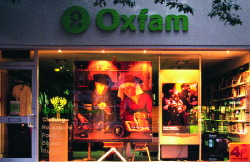Artranspennine03
Various Venues
Various Venues

One of the largest public art events ever held in England, 'Artranspennine03' (ATP03) occupies a dense urban sprawl stretching from the Humber to the Mersey. Curators Nick Crowe and Ian Rawlinson took their lead from 'Artranspennine98', a project initiated by Tate Liverpool and the Henry Moore Institute, which was designed to challenge the artistic dominance of London and to encourage greater co-operation between rival northern councils. Costing £3 million, the blockbuster languished from association with artists, curators and empires such as Tate. Many northern artists sniffed about surreptitious regional centralization generating megabucks for permanent artworks and museum expansion.
Crowe and Rawlinson wanted to celebrate the cultural diversity of the north by taking a more frugal and devolved approach. Noting that there were no 'official' plans for a trans-regional project this year, they simply appropriated the ATP trademark and purchased its domain name, transforming a fabricated Eurocommerce corridor into a cultural rallying cry.
ATP03 has benefited greatly from the bold enthusiasm of its local participants. Costing only £530 to host, it's bigger and more diverse than its predecessor. A key aim of ATP03 is to encourage critical responses to local geographies, especially towards the corporatization of public space. Non-places such as car parks and shopping centres feature frequently as sites and subject matter. Pippa Hale's coffee mugs, Souvenir (all works 2003), immortalize the identical high streets of Leeds, Manchester, Liverpool and Hull. David Osbaldeston's The Return of the Arcadian Shepherds creates a dialogue between Nicolas Poussin's vision of paradise and the leafy Neo-Classical interior of Manchester's Trafford Centre, a modern shopping Mecca. Placed in the Hayfield Public Library in the heart of the idyllic Derbyshire Peak District, Osbaldeston's drawings juxtapose Arcadian and urban capitalist invocations of Classicism. A comparably nuanced reading of the tension between the local and global, the rural and the urban, springs from Rachel Goodyear and James Hutchinson's Evening News. Loudspeakers planted around their garden play the mating calls of newspaper street vendors from across the Pennines. Martin Vincent took his soundwork FM62 on the road, launching his pirate radio station on the motorway between Leeds and Manchester, broadcasting pastoral tones for hermetically sealed drivers zipping between cities.
Some artists chose to insert their work directly into commercial environments. John Newling printed a copy of Quentin Metsys' The Money Changer and his Wife (1514) and placed it, for silent auction, in the window of an Oxfam shop in Liverpool. A deadpan satire of art's connection with money-laundering and charity, Newling's print entered directly into the secondary market, but not one commonly associated with contemporary art. Others drew heavily on the ambient interventions of Lawrence Weiner, whose work The Horizon is Now at the Edge of the Water was reinstalled from Hull to Radcliffe. Oliver East's Making One Hill Bigger Than Another, a work that involved removing a cubic foot of earth from one Pennine to another, subtly evokes the Land art antics of the 1960s. Meanwhile, in Manchester, Pavel Buchler embarked upon a cryptic fly-posting campaign featuring the legend 'Tonight', a viral celebration of the here and now. ATP03 revealed that poster works can still be an effective way of making transient, low-cost public art. A quip at global warming, Richard Bartle created a Sealife Centre by pasting images of an aquarium on to a pedestrian subway in landlocked Sheffield, while Corona Smith's Dream Posters let the citizens of Hull, Leeds and Liverpool in on his intimate nocturnal thoughts. Jim Medway's melancholic Swan - a can of lighter fluid beautifully painted to resemble a barge and tossed into Manchester's Rochdale Canal - was undoubtedly the most poetic coalition of public sculpture, heritage culture and disposable consumerism.
ATP03 took ephemerality to new lengths while mercilessly parodying the mediocre officialdom of institutional curating. Paul Rooney designed an audio guide for a Caderdale field, fabricating yet another historical site by mixing the language of the museum and the rockumentary. Dialogue and audience participation, once sacrosanct commandments of public art, were also subject to northern facetiousness. In Manchester, Paul Needam took out a series of advertisements in the local papers, announcing that he would wait for his phone to ring for a total of 24 hours during ATP03. Pre-empting the unwelcome attentions of art groupies, Needham neglected to give the times, or his number. The anonymous S5 curator in Leeds took Needham's studied reticence to alternative lengths, commissioning 23 artists without revealing their names or the whereabouts of their public works.
Like a dear departed pet, the best of ATP03 is memorable precisely because it no longer exists. Potent public art deserves a chance to fade. An ineffectual institutional branding exercise hijacked by quick-witted natives, ATP03 is a provocative prototype for clawing back public culture from corporatists.



















